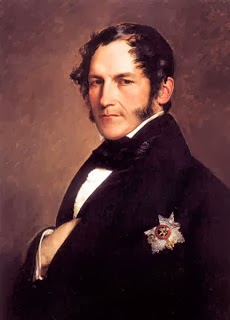On the night of 14 December, 1861, Queen Victoria lost her beloved husband Prince Albert. In the custom of the time, most of her subjects learned of his death through the tolling of church bells, traditional alert to crisis.
Prince Albert of Saxe-Coburg-Gotha, 1840
Victoria (H, not R) here. In 2011, 150 years after the event, the BBC History Magazine (one of my monthly treats), carried an article about how the death of Prince Albert threatened the continuing existence of the monarchy. Here is a topic with everything: love, dynasty, death and mourning, royalty, and Future Considerations, the capital letters well-deserved. Most of the information in this post comes from the magazine article by Helen Rappaport, author of Magnificent Obsession: Victoria, Albert and the Death that Changed the Monarchy, published by Hutchinson, 2011.
Victoria was already Queen when she and Albert of Saxe-Coburg-Gotha were married on February 10, 1840. There is no doubt that she adored him -- handsome, clever, and virile, Prince Albert had long been intended to be her spouse by their mutual uncle, Leopold, King of the Belgians, since 1831 and the widower of the late Princess Charlotte of Wales, who died in 1817.
Leopold 1, King of the Belgians; portrait by Winterhalter
King Leopold was the brother of both Victoria's mother, the Duchess of Kent, and Albert's father, Ernst I, Duke of Saxe-Coburg and Gotha.
Queen Victoria and Prince Albert with their children in 1846;
Painted by Franz Xavier Winterhalter
Queen Victoria and Prince Albert were parents of four sons and five daughters and eventually 42 grandchildren, most of whom married into European royalty and aristocratic families.
A film version, somewhat exaggerated, of the early years of the marriage.
There is little doubt from her writing that her marriage to Albert was a love match for Victoria. If those early years were difficult for Prince Albert, he was confident of her adoration, and he worked hard to win the confidence of her advisers, government officials, and the public.
2010 Exhibition at The Queen's Gallery, Buckingham Palace, London
Three years ago, Kristine and I attended the exhibition "Victoria and Albert: Art and Love" and feasted our eyes on the lovely portraits and objects they gave each other. According to the catalogue, "This exhibition is the first ever to focus on Queen Victoria and Prince Albert’s shared enthusiasm for art. Bringing together more than 400 items from the Royal Collection, it celebrates the royal couple’s mutual delight in collecting and displaying..." We examined each item, until we could hardly stand on our tired feet. Seeing their love so obviously expressed gave us a new appreciation of their mutual trust and dependence upon one another
Prince Albert, 1859, by Winterhalter
By the time he died, most people (according to Rappaport) considered Albert to be King in all but name. Regarding the press accounts of his death, Rappaport writes, "Many of them were tinged with a profound sense of guilt that Albert had never been sufficiently valued during his life time for his many and notable contributions to British culture as an outstanding patron of the arts, education, science and business." The Queen was plunged into a profound depression which lasted for many years.
The Death of Prince Albert
At the time of Albert's death at age 42, he was less than pleased with Prime Minster Palmerston's attitude toward the American Civil War, the PM being more sympathetic to the cause of the Confederacy due to the British import of American cotton. We will hear more about this controversy, known as the Trent Affair in an upcoming post about the Civil War, coming soon on this blog.
Victoria and Albert, 1854
As seemed to be common in the British Royal Family, first sons and their ruling fathers often did not see eye to eye. Prince Albert was disappointed in his eldest son, known as Bertie, who succeeded his mother as monarch King Edward VII in 1901. Albert had kept Bertie to a strict regimen of preparation for his eventual role as King, but Bertie, being young and mischievous, managed to involved himself in troublesome activities. The Queen, in part, blamed her son for her husband's illness and death.
Helen Rappaport, Daily Mail
The fear grew in Britain that the Queen would never recover from her grief, and her exaggerated mourning would endanger the continuation of the monarchy. Victoria and Albert had, during their 20-year reign, re-established the dignity of the royal family, so greatly reduced during the period of the Hanovers, the first four Georges and William IV.
Prince and Princess of Wales, wedding in 1863
Rappaport writes, Victoria "became increasingly intractable in response to every attempt to coax her out of her self-imposed purdah...the only thing that interested Victoria now was her single-handed mission to memorialize her husband in perpetuity."
The Albert Memorial, Kensington Gardens, London,
one of many memorials to the Prince Consort
Not until 1871 did Queen Victoria begin to appear in public again. Rappaport writes, "...discontent escalated into outright republican challenges and calls for Victoria's abdication...when Queen Victoria attended a thanksgiving service at St. Paul's Cathedral" to celebrate the recovery of the Prince of Wales from an attack of typhoid fever, the disease which may have killed his father ten years earlier. From then on, public sympathy was recovered for the Queen and her son.
Queen Victoria, 1899, NPG
With the help of her favorite PM, Disraeli, and her beloved Scottish servant, John Brown, the Queen became "...a respected figure of enduring dignity and fortitude, ageing into her familiar image...only now that people started calling themselves 'Victorian's'..."
Although the book is a couple of years old, I think Santa will get an order from me!
RIP, Prince Albert
Albert and Victoria, side by side, on their tomb
Royal Mausoleum at Frogmore where Victoria and Albert rest

























No comments:
Post a Comment